| Despite our best efforts, sometimes bad things happen to our prized tomato plants. Here's a list of tomato problems and solutions that I've compiled from a variety of sources including the University of California Cooperative Extension, California Department of Agriculture, United States Department of Agriculture, Rodale Press, University of Wisconsin Cooperative Extension, and Washington State Cooperative Extension. YOUNG PLANTS Symptom: Wilting and falling over at soil line. Problem: Damping off fungus. Solution: Use clean soil. Provide warm, well-drained seedbeds, control excess moisture. Symptom: Cut off near soil line. Problem: Cutworms or darkling ground beetles. Solution: Protect transplants with can or paper tubes reaching one inch below and above soil surface. Spray with Bacillus thuringiensis (Bt). At end of season, clean the area to discourage the cutworm from laying its eggs. GENERAL PLANT GROWTH Symptom: Tops become weak, pale, dwarfed, wilt easily, and die prematurely. Yield is lessened. Swelling on roots becoming distorted, enlarged, and decayed. Problem: Root knot nematode. Solution: Plant resistant varieties. Interplant with marigolds (especially dwarfs) or where marigolds were grown and dug into the soil. Symptom: Sudden wilting of plant and rapid rotting of roots. Problem: Phytophthora root rot brought on by excessive watering and lack of drainage. Solution: Correct irrigation techniques. Symptom: Deformed growth or wilt. Problem: Numerous insects sucking sap. Aphids found on undersides of leaves or clustered on new growth. Whitefly larvae on underside of leaves, adults fly up when foliage is disturbed. Solution: A few insects won't hurt production. Crush them onto leaves or stem. Spray with soapy water. Natural enemies of aphids include ladybug larvae and adults, syrphid fly larvae, lacewing larvae, and parasitic wasps. Symptom: Slow growth. Leaves paling from top of plant down. Leaves small and thin, with purple veins. Stems yellow and rigid. Flower buds yellow and drop off. Problem: Nitrogen deficiency. Solution: Apply nitrogen and compost. Symptom: Slow growth. Plants tinged purple. Leaves small and fibrous. Delayed fruit set. Problem: Phosphorous deficiency. Solution: Apply bone meal at planting time, and sidedress six weeks later. Symptom: Brittle young leaves that curl up and turn yellow away from stems. Green border on yellowed leaves. Problem: Magnesium deficiency. Solution: Incorporate dolomitic limestone or a handful of Epsom salts at planting time. Symptom: Blackened areas at growing tip of stunted stem. Terminal shoots curl, yellow, and die. Problem: Boron deficiency. Solution: Apply one teaspoon of borax around base of plant and water in. Symptom: Yellowed leaves with green veins. Problem: Iron deficiency. Solution: Add acidic supplement such as leaf mold or manure. Symptom: Stunted shoot growth, poor root development, bluish green foliage, leaves flabby and curled upward. Few or no blossoms. Problem: Copper deficiency. Solution: Apply manure. Symptom: Small, narrow leaves colored yellow between veins and mottled with dead areas. Stems may crack. Problem: Zinc deficiency. Solution: Apply manure. Symptom: Very slow growth. Yellowed areas between veins on leaves. Few blossoms, no fruit. Problem: Manganese deficiency. Solution: Apply manure. LEAVES Symptom: Roll upward and are firm and leathery, but with no yellowing or stunting. Leaves on the sunny side of staked plants may often curl, while those on the shady side do not. Problem: Common growth, no harm to plant development or fruit production. Too much leaf pruning, sucker removal, or overly wet soil may promote. Solution: Plant on well-drained soil. Do not cultivate deeply near the plants, and avoid extremely close pruning. Symptom: Roll upward and twist, become stiff and leathery, yellowed, stunted. Veins on underside turn purple. Problem: Curly top, western yellow blight. Transmitted by leafhopper from weeds. Solution: Use resistant varieties. Destroy infected plants. Symptom: Yellow and green mottling, crinkled, and smaller than normal, shoestring appearance. Problem: Mosaic viruses. Transmitted from weeds and flowers, aphids, cucumber beetles. Solution: Wash hands with soap and water before handling plants. Do not smoke or handle tobacco before or while handling plants. Remove and destroy infected plants. Symptom: Numerous small dark brown circular spots on young leaves, becoming bronzed and withered; older foliage is yellowed. Dark brown spots or streaks on stems near tips. Problem: Spotted wilt. Spread by thrips from weeds and ornamentals. Solution: Keep separate from vulnerable vegetables like lettuce, celery, spinach, peppers, and potatoes. Symptom: Yellowing, wilting, dying of lower leaves progressively up the plant. Initially, often affects only one side of the plant. Brown streaks in tissue of lower stem when split lengthwise. Produce few fruit which usually decay and drop before ripening. Problem: Verticillium or fusarium wilts. Solution: Plant resistant varieties. Use clean soil. Avoid areas previously planted with tomatoes, peppers, eggplant, potatoes, or cucurbits. Destroy infected plants. Symptom: Distorted, cupped, or curled, ragged at edges, curved downward. Light-colored veins appear parallel. Problem: Hormone-type herbicides. Solution: Use extreme care when using herbicides. Plants may outgrow damage if given good cultural care. Symptom: Irregular greenish-black water-soaked patches on older leaves which enlarge and may show a white, downy growth on surface. Fruits develop gray, green spot which becomes brown and wrinkled or corrugated; may become mushy. Problem: Late blight fungus. Solution: Prevalent in mild, moist weather. Hot, dry weather will slow or stop advance of disease. Symptom: Dark areas of dead tissue surrounded by yellow on oldest leaves. Problem: Anthracnose, a soil-borne fungus disease. Solution: Avoid handling wet plants or planting in poorly-drained soil. Rotate to new soil each year. Remove and destroy infected plants or plant parts after harvest. Symptom: Many tiny round holes, leaves may be so riddled that they turn brown and wilt. Problem: Flea beetles. Solution: A few holes are not damaging. Most damage occurs during the first warm weather of spring, when plants are small. Apply garlic spray. Symptom: Eaten or chewed, partially or entirely. Problem: Hornworm. Solution: If the worm is carrying white pupae, let it be -- it's the victim of a parasitic braconid wasp and should be left to nurture a new brood of beneficials. Remove worms by hand and destroy (sprinkling water on plant will make them wriggle, making them more visible and easy to pick). Spray with Bt. Release trichogramma wasps. Symptom: Greasy appearance becoming bronzed and stippled, webbing and "moving dust" on undersides of leaves or in leaf axils. Plant appears to dry out from the ground up. Leaves turn brown and paper-like but do not wilt. Problem: Mites. Solution: Thrive in hot, dry weather. Wash down plant, especially undersides of leaves. Use garden sulfur according to label directions. BLOSSOMS Symptom: Lush foliage, but no blossoms and few fruit. Problem: Too much nitrogen. Solution: Incorporate a balanced fertilizer at planting time. Do not feed more nitrogen during growing season. Symptom: Blossom drop. Problem: Plant is stressed due to cool night temperatures (below 58 degrees) or high daytime temperatures (over 90 degrees), unusually heavy fruit set, lack of moisture, poor soil fertility, too much shade, certain diseases, excessive nitrogen fertilizer, insufficient potassium or phosphorous, or an aphid infestation. Solution: Plant in full sun. Large-sized fruit varieties are very susceptible where summers are hot and dry. Choose varieties which produce small or medium-sized fruits. Cherry tomatoes tolerate cooler weather and set fruit better when air temperatures are in the low 50's. Blossom set will resume approximately seven to ten days after temperatures return to cooler levels. Readjust irrigation schedule. Natural enemies of aphids include ladybug larvae and adults, syrphid fly larvae, lacewing larvae, and parasitic wasps. FRUIT Symptom: Light-colored cloudy spots with pithy or corky areas just below the skin. Problem: Stink bug punctures. Solution: Remove by hand and destroy. Spray with insecticidal soap. Keep down weedy areas if bugs have been persistent. Plant smaller sections of crop, rather than large areas. Symptom: Hole at stem end and fruit hollowed out. Problem: Tomato fruitworm. Solution: Remove by hand and destroy. Spray with Bt or onion/garlic solution. Release trichogramma wasps. After harvest, turn soil to kill pupae. Symptom: Large holes or completely hollowed out. Problem: Slugs. Solution: Stake tomatoes and place mulch or boards under fruit to get them off the soil. Harvest frequently. Symptom: Hollow fruit. Problem: Poor pollination caused by low light (dark, cloudy days), too much nitrogen, heavy rainfall, temperatures that are too high (over 90 degrees) or too low (below 58 degrees), or too much hormone fruit-set spray. Solution: Set tomatoes out later in season and modify environment with hotcaps. Shade in hot weather. Use less fruit-set spray. Symptom: Cracks--concentric circles around stem or in lines radiating from center. Problem: Sudden, rapid growth during high temperatures (over 90 degrees) and high rainfall or heavy irrigation, especially after a dry spell. Ripening fruit and fruit exposed to the sun are most affected. Solution: Plant less-susceptible varieties. Keep soil evenly moist with proper watering techniques and mulches. Do not remove leaves from plants. Do not irrigate just before harvest. Symptom: Black mold along growth cracks. Problem: Damaged, cracked tissue developing under warm, moist conditions. Solution: Prevent fruit cracking (see above). Handle fruit carefully. Symptom: Misshapen fruit but with no scars. Problem: Inadequate moisture, fruit confined in foliage. Solution: Water deeply and more frequently, especially during hot spells. Provide trellising, free fruits from binding. Symptom: Catfacing -- misshapen, puckered, swollen areas; cavities lined with scar tissue. Problem: Incomplete pollination due to 1) weather being too cool or hot, 2) bees not being available, or 3) overhead irrigation during blossoming that makes blossom cling to itself, resulting in abnormal shaping of the fruit. Common on early fruit of varieties that produce large-size fruit. Solution: Plant less-susceptible varieties, including those bearing smaller fruit. Encourage bee activity. Irrigate under foliage. Symptom: Circular sunken spots on skin which enlarge and darken. Problem: Anthracnose. Solution: Plant in well-drained soil. Destroy plants and fruits (don’t compost). Symptom: Blossom-end rot – water-soaked area on blossom end which darkens and becomes larger, sunken, and leathery. Problem: Related to lack of calcium due to lack of water when plants have grown rapidly during the early part of the season and then are subjected to hot dry weather when the fruits are in an early stage of development. More severe in sandy soils and soils with a high salt content. Solution: Plant less-susceptible varieties. Refrain from planting in very cool soils. Calcium is not available to plants at a low soil pH, so incorporate dolomitic limestone at time of transplanting. The finer the grade of limestone, the faster it breaks down in the soil, and the sooner it raises the pH and enables the calcium to be utilized. Keep soil evenly moist with more thorough irrigation. Stake tomatoes or mulch beneath them to get fruit off ground. Symptom: Brown, slightly sunken spots which enlarge, darken, and break open. Problem: Soil rot fungus where fruit are allowed to lie on the soil or are repeatedly splashed by rain or overhead irrigation. Solution: Plant in well-drained soil, stake tomatoes, and mulch beneath them. Symptom: White or yellow patches on parts of green or ripening fruit which face the sun; become blisterlike and form large, flattened, grayish-white areas with a dry paperlike surface. Problem: Sunscald, most frequent during hot dry weather and on plants which have lost foliage from pruning or disease. Solution: Some varieties with little foliage are more tender and sunscald more easily. Do not remove leaves from plants. Where fruits are exposed, put a light covering over the clusters to diffuse the direct sunlight. |
|
3 Comments
|
Categories |





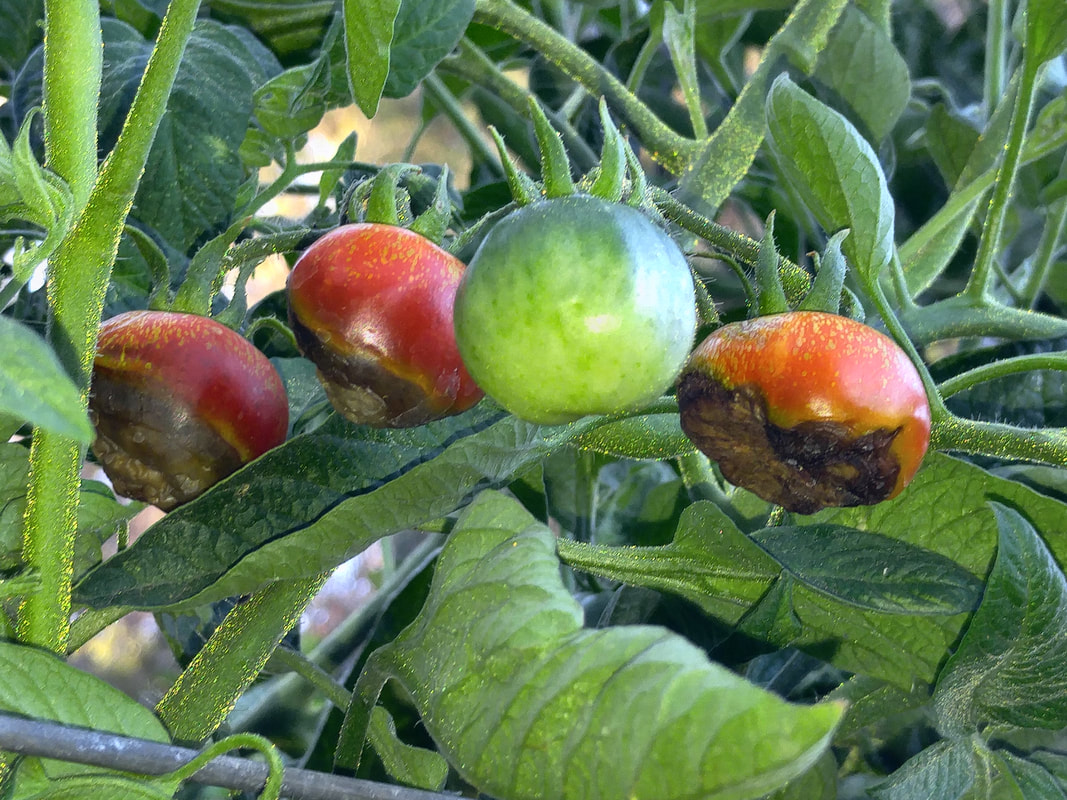




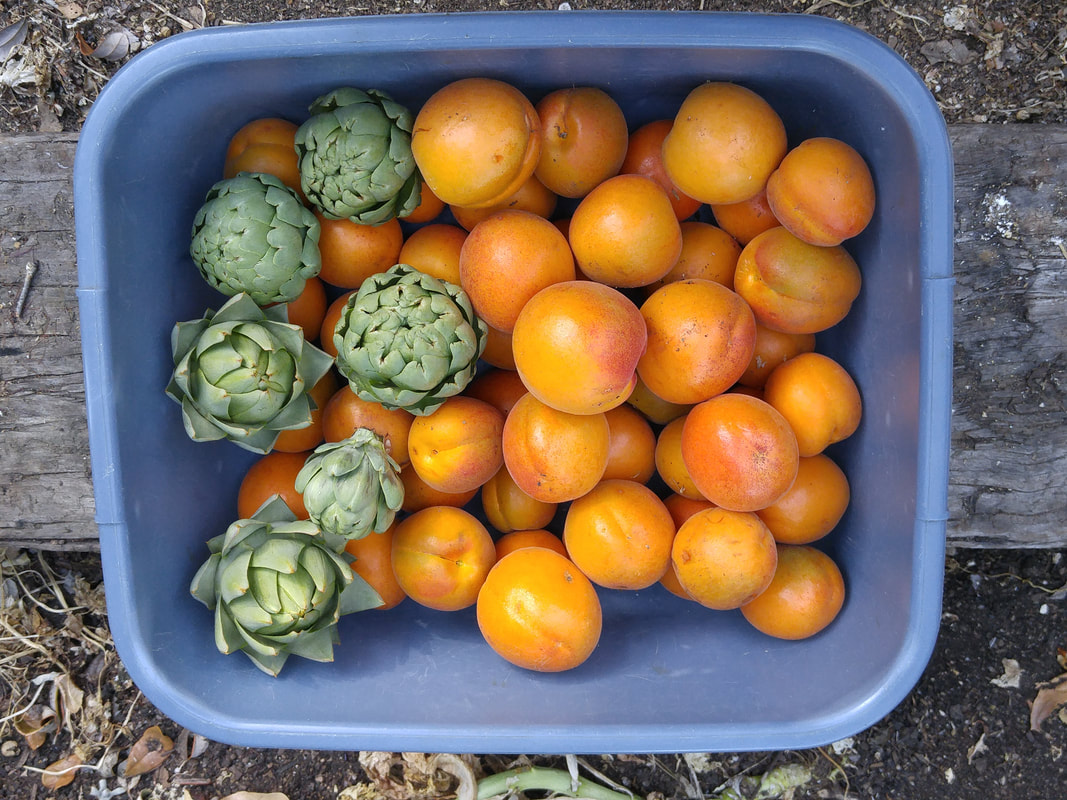
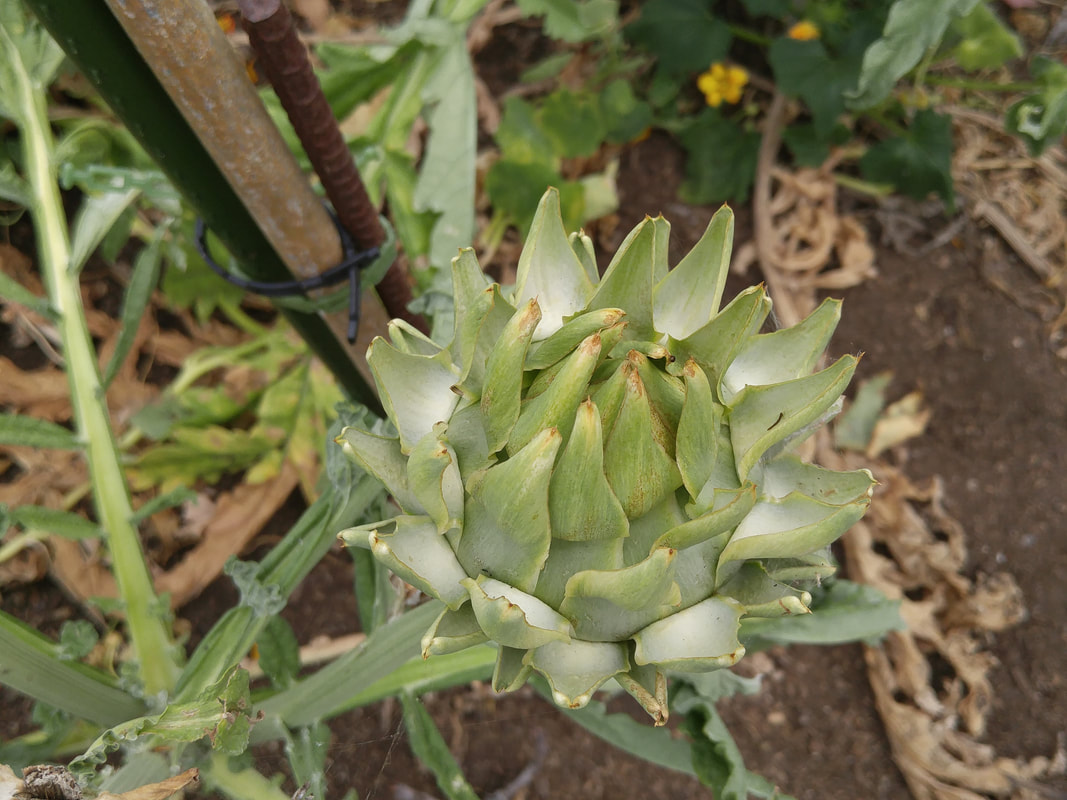

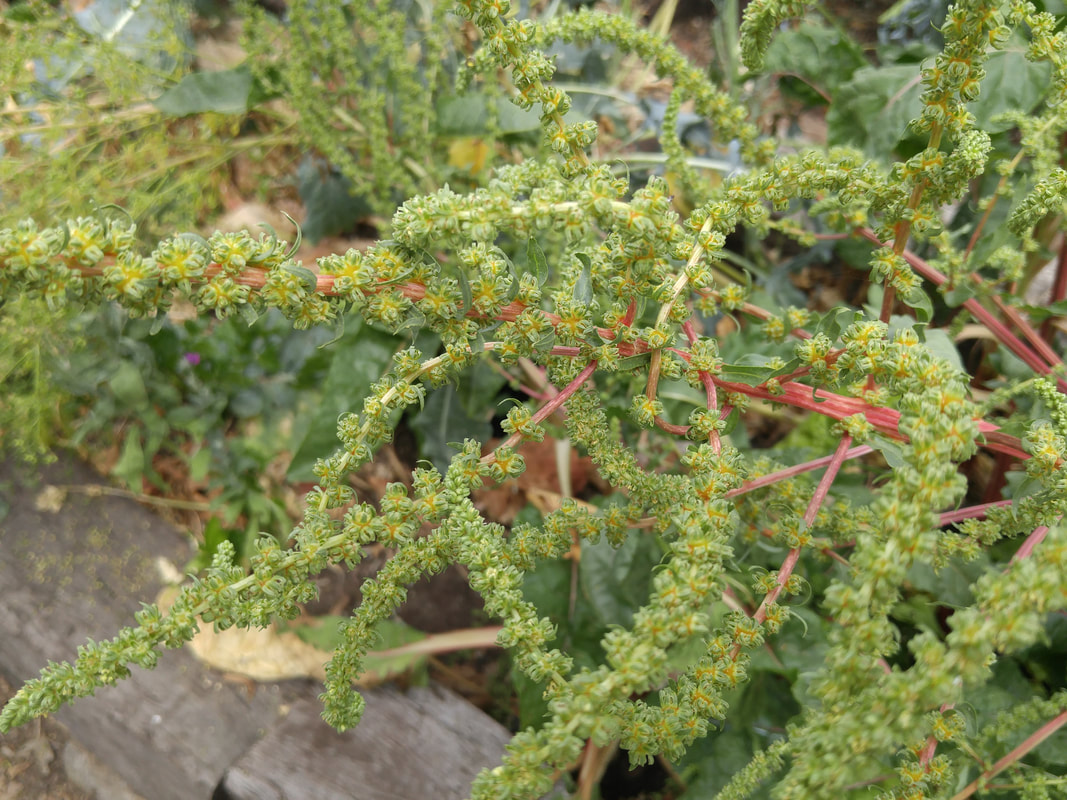
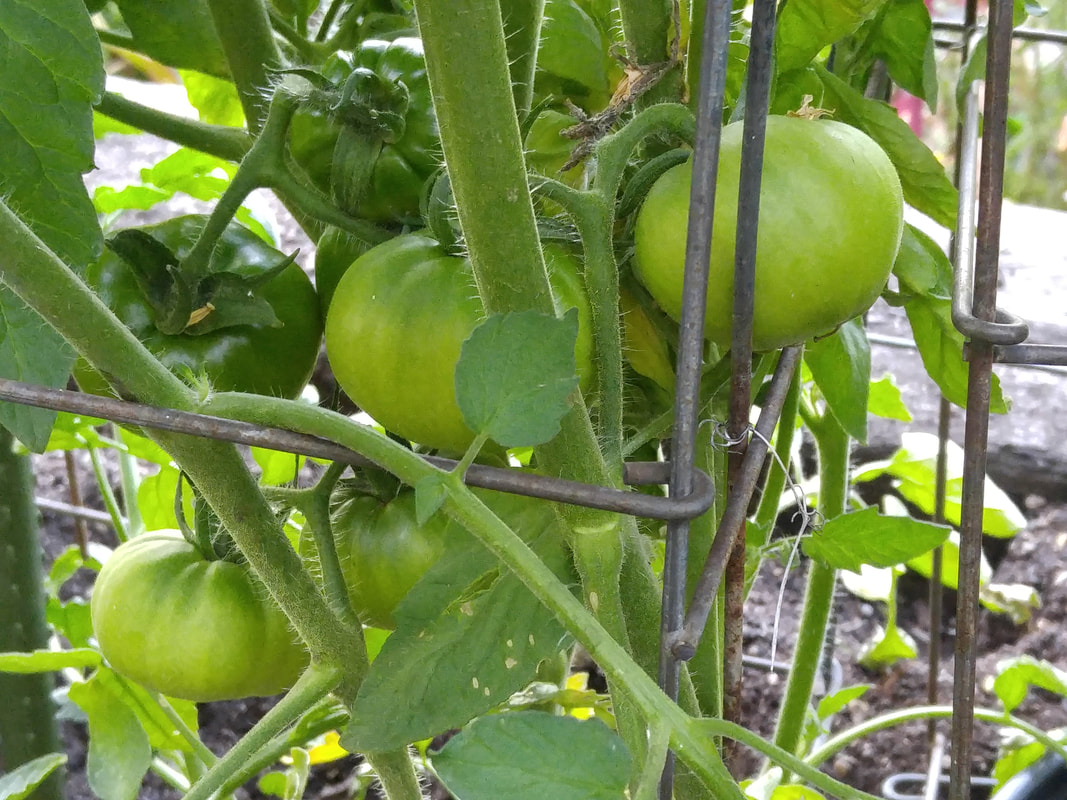











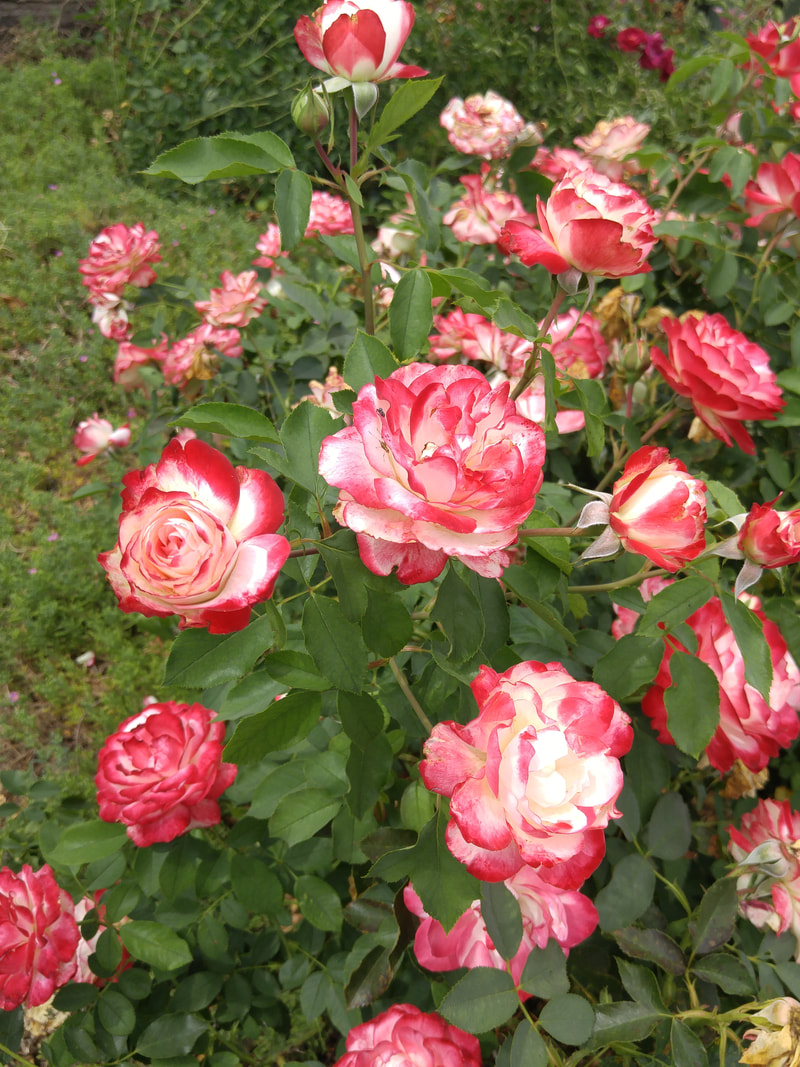








 RSS Feed
RSS Feed